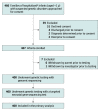Rapid Whole-Genomic Sequencing and a Targeted Neonatal Gene Panel in Infants With a Suspected Genetic Disorder
- PMID: 37432431
- PMCID: PMC10336625
- DOI: 10.1001/jama.2023.9350
Rapid Whole-Genomic Sequencing and a Targeted Neonatal Gene Panel in Infants With a Suspected Genetic Disorder
Abstract
Importance: Genomic testing in infancy guides medical decisions and can improve health outcomes. However, it is unclear whether genomic sequencing or a targeted neonatal gene-sequencing test provides comparable molecular diagnostic yields and times to return of results.
Objective: To compare outcomes of genomic sequencing with those of a targeted neonatal gene-sequencing test.
Design, setting, and participants: The Genomic Medicine for Ill Neonates and Infants (GEMINI) study was a prospective, comparative, multicenter study of 400 hospitalized infants younger than 1 year of age (proband) and their parents, when available, suspected of having a genetic disorder. The study was conducted at 6 US hospitals from June 2019 to November 2021.
Exposure: Enrolled participants underwent simultaneous testing with genomic sequencing and a targeted neonatal gene-sequencing test. Each laboratory performed an independent interpretation of variants guided by knowledge of the patient's phenotype and returned results to the clinical care team. Change in clinical management, therapies offered, and redirection of care was provided to families based on genetic findings from either platform.
Main outcomes and measures: Primary end points were molecular diagnostic yield (participants with ≥1 pathogenic variant or variant of unknown significance), time to return of results, and clinical utility (changes in patient care).
Results: A molecular diagnostic variant was identified in 51% of participants (n = 204; 297 variants identified with 134 being novel). Molecular diagnostic yield of genomic sequencing was 49% (95% CI, 44%-54%) vs 27% (95% CI, 23%-32%) with the targeted gene-sequencing test. Genomic sequencing did not report 19 variants found by the targeted neonatal gene-sequencing test; the targeted gene-sequencing test did not report 164 variants identified by genomic sequencing as diagnostic. Variants unidentified by the targeted genomic-sequencing test included structural variants longer than 1 kilobase (25.1%) and genes excluded from the test (24.6%) (McNemar odds ratio, 8.6 [95% CI, 5.4-14.7]). Variant interpretation by laboratories differed by 43%. Median time to return of results was 6.1 days for genomic sequencing and 4.2 days for the targeted genomic-sequencing test; for urgent cases (n = 107) the time was 3.3 days for genomic sequencing and 4.0 days for the targeted gene-sequencing test. Changes in clinical care affected 19% of participants, and 76% of clinicians viewed genomic testing as useful or very useful in clinical decision-making, irrespective of a diagnosis.
Conclusions and relevance: The molecular diagnostic yield for genomic sequencing was higher than a targeted neonatal gene-sequencing test, but the time to return of routine results was slower. Interlaboratory variant interpretation contributes to differences in molecular diagnostic yield and may have important consequences for clinical management.
Conflict of interest statement
Figures


References
-
- Lavelle TA, Feng X, Keisler M, et al. . Cost-effectiveness of exome and genome sequencing for children with rare and undiagnosed conditions. Genet Med. 2022;24(6):1349-1361. - PubMed
-
- Yang L, Wei Z, Chen X, et al. . Use of medical exome sequencing for identification of underlying genetic defects in NICU. Clin Genet. 2022;101(1):101-109. - PubMed

